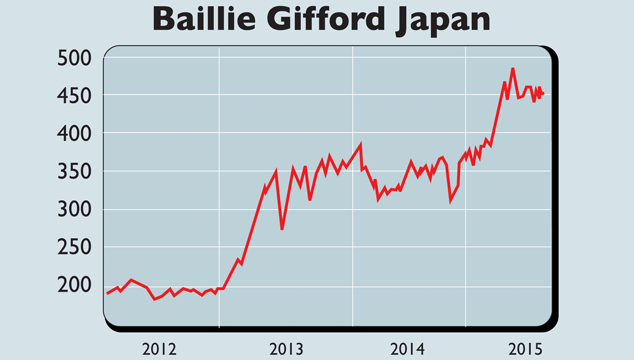Why Japan has me trembling, but excited
Old Japan hands will have heard it all before, says Rupert Foster. But this time really is different. It’s time to buy Japan.


Old Japan hands, like me, will have heard it all before, says Rupert Foster.But this time really is different. It's time to buy Japan
I started out as a Japanese equity fund manager in January 1995 so I know what it feels like to be a pariah. There have been occasional bouts of interest from global investors the last under the Junichiro Koizumi government in 2005-2006. These tend to end amid policy errors (the rise in the consumption tax in 1997), or the refusal of Japanese politicians to accept reform. So the naysayers had plenty of historical evidence to point to to denigrate the birth of "Abenomics" in 2013 the programme of Shinzo Abe, the prime minister, to boost the long-stagnant economy.
Yet the MSCI Japan index is now rising and outperforming a rising MSCI World index and has been doing so for the longest period since 1989. Are we finally at the point when change will sweep Japan into the 21st century?
Subscribe to MoneyWeek
Subscribe to MoneyWeek today and get your first six magazine issues absolutely FREE

Sign up to Money Morning
Don't miss the latest investment and personal finances news, market analysis, plus money-saving tips with our free twice-daily newsletter
Don't miss the latest investment and personal finances news, market analysis, plus money-saving tips with our free twice-daily newsletter
Japan saw the most dramatic change of any global economy between 1945 and 1990. From a near-standing start, Japan ended up competing with the US to be the top economic superpower. Japan has always been the world's leading socialist (with a small "s") country. After World War II its people made an unwritten agreement to give up personal rights and aspirations for the collective good.
Democratic politics was abandoned (having been very active before the war) for a technocratic government led by one party the LDP and by the all-powerful bureaucrats at the Ministry of Finance (MoF). Average incomes soared, without creating large wealth disparities. In 2010 the average Japanese CEO was on 16 times the salary of the average worker; for American CEOs, the figure is more than 300 times (excluding stock grants).
Flaws in the Japanese model
But the wonderfully successful Japanese model hit the buffers as the real-estate bubble burst in 1990. Since then, Japan has seen more than 20 years of economic dormancy. Japanese technocrats made many policy errors in the 1980s, but overall it was the sheer success of the model that led to its canonisation, and therefore its ossification. The MoF, for example, has remained an intensely arrogant institution for most of my career, through a string of disasters.
Change only started to appear with the breakdown of the LDP's monopoly on power. They were first dumped from government in 1993. But the longest period of non-LDP power was from 2009 to 2012, before Shinzo Abe returned the LDP to government. Before 2005 the smaller political parties had been made up largely of LDP-turncoats. But the advent of the DPJ and "Your Party" saw a genuinely new political dynamism. These politicians did not target traditional LDP voters, but the disaffected a large group in Japan. From 1990 to 2005, the average election turnout for 20-somethings fell from 58% to 38%. If any political party could harness those potential voters, they could sweep the LDP from power permanently.
In the end, the DPJ and other opposition parties proved to be venal and inept, giving the LDP a chance to recover. Meanwhile, the changing make-up of Japan's voters has helped persuade the LDP hierarchy of the need to change. The LDP party machine, the best in the country by some distance, had by the 1990s become increasingly focused on its core voters rural and semi-rural small-business owners.
Many of these voters were in agriculture and construction (the largest employer in Japan). So they liked pork-barrel politics, endless fiscal stimulus anyone who has visited Japan will have a sense of how much of the nation has been concreted over as a result and were not especially interested in economic growth.
They were also keen to keep the tax system in place. Japan has one of the friendliest tax departments in the world. Tax returns for small businesses have historically never been reviewed by the tax bureau they are simply accepted at face value. Wily small business owners soon got wind of this, and began putting all of their personal expenses through their companies there are four million small businesses in Japan that have never made a profit.
Even though it is one of the most law-abiding countries in the world, tax avoidance has been rampant for years, which is one reason why Japan has such a mountain of government debt. Unsurprisingly, tax reform is a key feature of Abenomics.
The changing face of Japan's voters
But the LDP's core voters were shrinking. The urban middle class was now by far the largest group in society. And these people were employees, not small business owners. Their income came from salaries on which they paid tax at source, and depended on their employers' earnings, which in turn depended on the health of the economy. Many of these voters were forced into early retirement by the harsh restructurings of corporate Japan in the previous 15 years and were increasingly disaffected. All the other parties had focused on this group.
Abe realised he needed to switch so he realigned the LDP as the urban middle-class party. That's what Abenomics is a collection of policies designed to attract votes from the urban middle class.It marks a structural change in Japanese policy. All parties agree on this change there will be no going back.
The question is whether the speed of change will keep avaricious foreign investors happy. Abe's problem is similar to that of Xi Jinping in China. They are both trying to sell reform not to the voters (who are already committed to change), but to their own parties, who after long periods in power have become dangerously conservative. The incentives of party members in the LDP (and in China, the Chinese Communist Party) need to be changed. This will take time and huge effort. In China, an anti-corruption drive demonstrated the determination for change. In Japan, which has a more rigorous legal system, achieving something similar will be harder, and will take longer.
Abe cleverly realised that he had to get the economy going first to buy himself time to make structural changes to the labour market, and also to the tax system, to enable the country over time to reduce government debt. He found two levers he could move on his own appointing the Bank of Japan (BoJ)governor, and appointing the minister of health, who had control of the main government pension scheme (the GPIF).
He appointed Haruhiko Kuroda as BoJ chief with strict instructions to weaken the yen. This has always been the easiest way to get Japan's export-driven economy going. Kuroda has done a phenomenal job the yen has fallen by 50% against the dollar since late 2012 and by 55% against the South Korean won. This has delivered earnings growth across large swathes of corporate Japan this year earnings are forecast to be 22% higher, and that was before the most recent bout of yen weakness. A significant part of discretionary consumption in Japan comes from the twice-yearly bonuses awarded to staff, which is directly linked to corporate earnings. So yen weakness has benefited the whole economy.
To move his second lever, Abe appointed Yasuhisa Shiozaki as minister of health. His first ruling was to state that the GPIF, the world's largest pension scheme with assets of $1.1trn, needed to move its investment stance to be more in line with Calpers, the largest public pension fund in the US. Calpers had an equity weighting of 64% the GPIF's weighting was 24%.
Much of this shift in weighting would flow into domestic equities, representing a $200bn splurge. And with many other pension schemes likely to track the GPIF, the full effect of this change might well be multiples of the headline number. The stockmarket surged in expectation, and the wealth effect flowed through the economy.
This takes us to today. The yen could weaken further to around 130 to the dollar. But if it weakens further, the effect could turn negative as Japan imports inflationary pressures. The authorities could then lose control of monetary policy. Japan still has a mountain of government debt and must not let bond yields rise too fast. The GPIF and other domestic investors haven't moved to their full equity weighting yet, but the initial surprise has been felt. So for the market to travel higher, Abenomics will have to deliver on its so-called "Third Arrow" structural reform.
The rebirth of corporate Japan
Here again, there is much help available from the weaker currency and the new-found cult of equity. It's impossible to exaggerate the awful effect that the Korean won devaluation of 2008 hadon Japan between 2009 and 2012. Korean companies have always been among the most aggressive, aping the approach adopted by Japan in the 1980s and early 1990s. Between 2009 and 2012, Korean firms put Japan to the sword. Most Japanese firms had been driven by one or two products during their boom years, but the grinding negativity of 1995-2013 saw Japanese firms diversify their revenue sources and become very defensive and cautious.
Given this recent history, it's no surprise that Japanese companies have taken the recent benefit from the weak yen and simply banked it. Now Abe and Kuroda need to convince them that the yen will stay weak for a long time no less than 110 versus the dollar, and preferably 120. Japanese firms will then have to build this into their long-term pricing policies. Between 2008 and 2012, lots of Japanese businesses lost market share to foreign firms, mainly Korean ones.
The first step in the rebirth of corporate Japan is to take back that market share. To do this, it needs to gamble the gains made from the weak yen on cutting prices to win back market share. The first step should be an explosion in investment (capital expenditure, or capex). Corporate Japan has focused on cost cutting for the past ten years or more capex expansion was out of the question.
Yet Korean groups thought nothing of raising capex by 40%-50% a year, in their dash for market share. The decision to become aggressive again has been tough for Japanese executives, but there are strong signs that this is now happening.
Sony was emblematic of Japan's early success. Now, the start of its turnaround is representative of the shift in mentality that corporate Japan has been through. Sony recently announced a $3.6bn rights and bond issue, to fund a fourfold jump in capex for its key product, CMOS image sensors the highest value component in a smartphone camera. Sony is fighting off competition from Korea, China and Taiwan by rapidly expanding production capacity while hanging on to its pricing and technical advantage.
Other firms, such as Toyota, are starting to move capex spending back to Japan from overseas. There are also signs that pricing is becoming more aggressive. The newly signed TPP trade deal will help, as it will allow easier access to US markets for key industrial products.
More money for the workers
Corporate Japan has also taken on board Abe's exhortations to raise wages. In fact, this has proved easy because of rising profitability. Japan's poor demographics have exacerbated labour-market tightening no bad thing, as the tighter the labour market, the quicker wages will rise. That said, in the longer run, just as China can fight poor demographics with a new surge in urbanisation, Japan can fight it by bringing more women into the workforce.
Currently women's participation in the workforce is 25% below men's in Japan that's twice the size of the gap in the UK. And just 6% of career-track employees are women. The International Monetary Fund (IMF) reckons that if Japan raised female participation in the workforce to global norms, it would add 5% to GDP over that time. A rise to developed European levels would raise GDP a further 5%.
Elsewhere, confidence is returning to the residential property market. Prices in Tokyo rose by 2.1% in 2013, and look set to rise another 2% in 2014. That might not sound like much, but it's a dramatic turnaround for Japan. In a nation where deflation has been prevalent for more than a decade, it takes time to reacquaint consumers with the idea that they need to buy now to avoid price rises. But change is slowly happening. Rakuten, Japan's leading ecommerce marketplace, has noted a strong recovery in premium mass spend per customer over the last year. These effects will mushroom over the next two to three years.
Playing nicely with shareholders
The GPIF has also been used as a toolfor another part of Abenomics improving the returns of Japanese corporations. Japan launched a Stewardship Code demanding, among other things, a return on equity (RoE) of above 5% over five years. The Nikkei launched a new index to favour high ROE companies. Leading Japanese machinery company Amada promptly ditched its decades-long head-in-the-ground approach to shareholder returns, announcing a 100% payout ratio for the next two years and a medium-term ROE target of 10%.
Meanwhile, leading machinery and robotics firm Fanuc which has spent years operating from a Bond-baddie-style mountain hideout near Mount Fuji, where investors were never allowed to visit caved in to an American activist investor and raised its dividend payout ratio from 30% to 60%, boosting its yield to 3.1% this year and 5.6% in two years, if analysts' forecasts are correct.
Japanese companies are aware that, against a backdrop of quantitative easing (QE), the best way to boost your share price is to raise dividends and buy back shares. American firms have been perfecting this art since 2010. But shareholders in Japan have always held third place behind customers and employees. So why does Japanese management suddenly care about share prices? It's due to behind-the-scenes encouragement by the government to break the cross-shareholding structure in Japan.
Traditionally, cross-shareholders have controlled Japanese companies, with the company's banker acting as the leader of the cross-shareholding group. As a result, no aggressive merger and acquisition (M&A) activity can take place when a share price is low, unless the company's banker agrees. This is rarely the case.
But now that system is finally breaking Japanese banks have agreed to abandon the model. As a result, underperforming Japanese companies could now be targets for M&A. Management teams will have to fight back in the only way they can by raising their share prices. (Some might argue that this is all that is needed to encourage share-price gains and that Western-style share-option schemes, which do not exist in Japan, serve no purpose bar enriching managements beyond the dreams of Croesus.)
We have not yet even mentioned Japan's evolution as the premier tourist destination for north Asians. Japan has almost no crime, an immensely friendly population, and the best culinary and retail experience across Asia. The Chinese have just started arriving, and the advent of large casinos in Japan in the next few years will accelerate this trend.
Some warning signs to watch
All this eulogising should make any old Japanese investor weak with nerves. This doesn't happen this is Japan. Something will go wrong. This can't be the leading developed-economy equity market for the second year in a row! And undoubtedly there is much that can go wrong but luckily for any foreign investor, the canaries in the coal mine are visible to all.
The first canary is the yen. If it moves much higher than 130 against the dollar, or much lower than 105, for more than three months, then all bets are off. Secondly, if Abe and Kuroda fall out, all bets are off. Last year Abe played with fire by telling a barefaced lie he told Kuroda that he would raise the consumption tax, prompting Kuroda to accelerate his money-printing operation. Then Abe changed his plans, delaying the next consumption-tax hike for at least two years, thus bagging a free hit on the QE pipe. Kuroda was miffed, but currently they remain together.
Thirdly, Abe could lose electoral support. All Japanese PMs require their poll support to remain high to give them the mandate for change. If it drops noticeably and consistently, then again, all bets are off.
Finally, for now, in the very short run, like all equity markets, there appears to be some overheating in Japan. But with these caveats in mind, this old Japan hand signs off trembling but excited reaching for his evening shochu aisu.
Rupert has been a pan-Asian equities fund manager for the last 20 years.
The six investments to buy now

Here at MoneyWeek we've been fans of Japan for a long while, writes John Stepek. And since Abenomics kicked off, that's been very profitable. So what are the best ways to get exposure to the market? On the currency front, we wouldn't worry too much about hedging the yen this introduces a tricky timing element to your investment decision and, as Rupert notes above, the days of yen weakness may soon be behind us.
We're keen on investment trusts generally. Two Japanese options we regularly mention are the Baillie Gifford Shin Nippon (LSE: BGS) MoneyWeek editor-in-chief Merryn Somerset Webb is a non-executive director on this trust and Baillie Gifford Japan (LSE: BGFD). BGS, which focuses on smaller stocks and trades at a premium to net asset value of 2.4%, has returned 98% since the start of 2013. BGFD, which holds small-to-midcap stocks, is up by 121% and trades on a 5% premium.

We don't usually like buying trusts at a premium, so it might be better to wait for a correction to pick them up at a discount. Aberdeen Japan (LSE: AJIT) is on a smaller premium of around half a percent, and is up around 64% since the start of 2013, which is still better than the Topix index (in sterling terms, at least). And Atlantis Japan Growth (LSE: AJG) is on a discount of 8.5% and is up 54% over the same period. Unit trusts with good records include the Neptune Japan Opportunities and Legg Mason Japan funds.
Rupert is an investment strategist and adviser at J & C Foster, providing Asian, Consumer and Global Equities Strategy advice to a number of family offices and portfolio management organisations. He writes on Asia and Global Macroeconomics for a number of investment publications including MoneyWeek and HL Investment Times.
-
 Should you invest in UK equities?
Should you invest in UK equities?The FTSE 100 hit a record high this week, but UK equities remain unloved and undervalued compared to their global and US peers. Should you snap them up at a discount?
By Katie Williams Published
-
 State pension errors: DWP urged to check for mistakes among divorced people
State pension errors: DWP urged to check for mistakes among divorced peopleFormer pensions minister Steve Webb says there are a high number of divorced women on low state pensions. Now MPs want the DWP to check if there were any errors in “potentially underpaying men and women who are divorced”.
By Ruth Emery Published
-
 Invest in space: the final frontier for investors
Invest in space: the final frontier for investorsCover Story Matthew Partridge takes a look at how to invest in space, and explores the top stocks to buy to build exposure to this rapidly expanding sector.
By Dr Matthew Partridge Published
-
 Invest in Brazil as the country gets set for growth
Invest in Brazil as the country gets set for growthCover Story It’s time to invest in Brazil as the economic powerhouse looks set to profit from the two key trends of the next 20 years: the global energy transition and population growth, says James McKeigue.
By James McKeigue Published
-
 5 of the world’s best stocks
5 of the world’s best stocksCover Story Here are five of the world’s best stocks according to Rupert Hargreaves. He believes all of these businesses have unique advantages that will help them grow.
By Rupert Hargreaves Published
-
 The best British tech stocks from a thriving sector
The best British tech stocks from a thriving sectorCover Story Move over, Silicon Valley. Over the past two decades the UK has become one of the main global hubs for tech start-ups. Matthew Partridge explains why, and highlights the most promising investments.
By Dr Matthew Partridge Published
-
 Could gold be the basis for a new global currency?
Could gold be the basis for a new global currency?Cover Story Gold has always been the most reliable form of money. Now collaboration between China and Russia could lead to a new gold-backed means of exchange – giving prices a big boost, says Dominic Frisby
By Dominic Frisby Published
-
 How to invest in videogames – a Great British success story
How to invest in videogames – a Great British success storyCover Story The pandemic gave the videogame sector a big boost, and that strong growth will endure. Bruce Packard provides an overview of the global outlook and assesses the four key UK-listed gaming firms.
By Bruce Packard Published
-
 How to invest in smart factories as the “fourth industrial revolution” arrives
How to invest in smart factories as the “fourth industrial revolution” arrivesCover Story Exciting new technologies and trends are coming together to change the face of manufacturing. Matthew Partridge looks at the companies that will drive the fourth industrial revolution.
By Dr Matthew Partridge Published
-
 Why now is a good time to buy diamond miners
Why now is a good time to buy diamond minersCover Story Demand for the gems is set to outstrip supply, making it a good time to buy miners, says David J. Stevenson.
By David J Stevenson Last updated